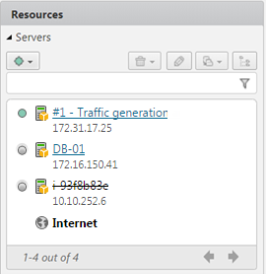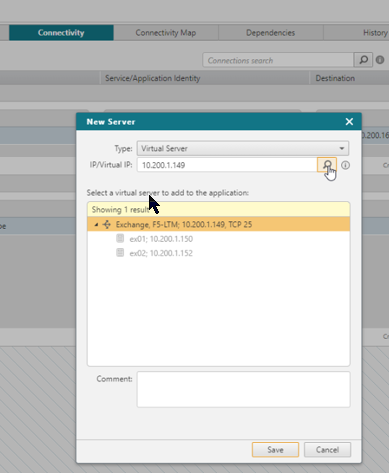On This Page
Creating Servers
Servers are network resources that you can add to the source or destination of a connection to define the connection traffic. When you define a server or server group, it is associated with your application.
You can define either:
-
A server that represents a host or group of hosts defined either as a:
-
Host: Single IPv4 or IPv6 address
-
IP range: Range of IPv4 or IPv6 addresses defined by start and end addresses
-
Subnet: Subnet of IP
-
Virtual server: F5 server or load balancer, monitored by SecureTrack, and defined by a Virtual IP; the server reroutes traffic to a group of servers, or virtual-server group members, that can equally process that traffic
When you add a virtual server to the source of a connection, tickets opened for that connection allow traffic from the IP addresses of the virtual server group members. When you add a virtual server to the destination of a connection, tickets opened for that connection allow traffic to the virtual IP address of the virtual server.
-
-
A server group that contains a list of server members that are already defined in SecureApp
To make changes to connections, it may be easier to add server groups to the connections. In this way:
-
You can change a list of group members without adding or removing the group object from the connections that use it.
-
When you create a ticket, the ticket includes all firewall changes that need to be implemented as a result.
After you add a server to connections, you can also replace that server with a group.
Define a New Server or Server Group for an Application
-
From the list of applications, click on the application that the server is associated with.
The application opens in the Connectivity tab.
-
In the Resources pane, click on Servers to see the servers in your application.
-
Click
 and select either New server or New server group.
and select either New server or New server group. -
Enter the details for the server or server group.
-
Server - Select the type of server.
-
Host: Single IP address. You can enter the DNS name as the mandatory Name and click
 to automatically fill in the IP address, or you can enter the IP address and click
to automatically fill in the IP address, or you can enter the IP address and click  to automatically fill in the DNS name.
to automatically fill in the DNS name.If you do not have DNS configured, the name is filled in automatically based on the Server Name syntax in Settings > SecureApp Settings.
-
Subnet: Set of IP addresses defined by a (mandatory) Name, network address and subnet mask.
-
IP range: Set of IP addresses defined by a (mandatory) Name, start and end address.
-
Virtual server: F5 Server or load balancer, monitored by SecureTrack, with a virtual IP address that reroutes traffic to a group of servers, or virtual-server group members, that can equally process that traffic. You can search for the virtual IP or the IP address of one of the virtual-server group members and select the virtual server to add.
You can add these virtual servers to your SecureApp connections by selecting New Server -> Type: Virtual IP and searching by IP:
When you create a server without an IP address, the new server can be used as a "place holder" to be filled in later by another user. A server without an IP address is shown in SecureApp with the icon, and a server with an IP address is shown with the
icon, and a server with an IP address is shown with the  icon.
icon.
You can then assign the IP address by editing the server details at another time, or copy the IP of another server when you deploy an application. -
-
Server group: Enter the name and description of the group. You can select the servers to include in the group, or you can click New Server to create a new server and automatically add the new server to the group, or save the group without any servers and add the servers later.
After you create a group, to search for members within the group, you can:
-
Select the group from the Resources and click
 .
. -
View a connection where the group is used and click on the name of the group.
-
-
-
Click Save.
You can now add the server or server group to a connection, or select the server or server group and click ![]() to change the details.
to change the details.
Define a cloud resource for an application
VM instances are added as server resources when they are associated with an application. See Auto-Associate Cloud Resources or Manually Associate a Cloud Resource for details. Cloud resources associated with an application display as server resources with the ![]() icon.
icon.

The state of the instance is displayed, as follows:
![]() - Instance is active
- Instance is active
![]() - Instance is inactive. If the name of the instance is shown with strikethrough font, then the instance has been terminated in the cloud or monitoring of that instance was removed from SecureTrack.
- Instance is inactive. If the name of the instance is shown with strikethrough font, then the instance has been terminated in the cloud or monitoring of that instance was removed from SecureTrack.
The icon does not identify connectivity status. It identifies only the state of the instance.
Select the cloud instance and click ![]() to change the details.
to change the details.

